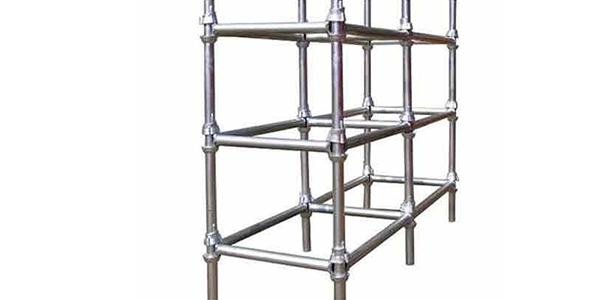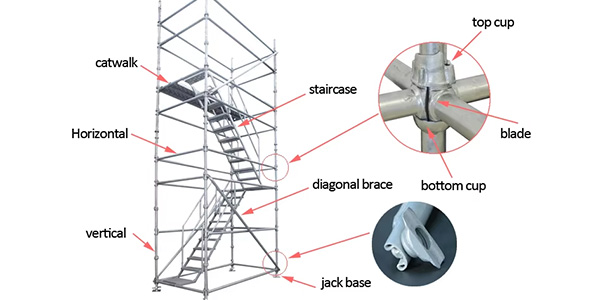Guía completa de tamaños estándar de andamios Cuplock que debe conocer
Apr 21, 2025El andamiaje es un elemento fundamental en la construcción de edificios, ya que proporciona soporte y acceso temporales. El sistema de andamiaje Cuplock es robusto, adaptable y soporta grandes cargas. El uso de medidas dimensionales estandarizadas garantiza una instalación rápida y estable. A continuación, analizaremos las medidas dimensionales estándar para el andamiaje Cuplock, incluyendo montantes verticales, largueros, travesaños y otros elementos clave. Esto le ayudará a determinar el sistema más adecuado para su proyecto de construcción.

Andamios con sistema de bloqueo de copa Es un sistema de andamios modulares que se caracteriza por su rapidez, resistencia y adaptabilidad en aplicaciones de construcción. Este tipo de andamio se utiliza frecuentemente en diversas estructuras de soporte, plataformas de acceso y para sostener edificios de gran altura, puentes e instalaciones industriales.

El montante, o vertical, es el principal elemento portante del sistema. Sus dimensiones determinan la altura total y la resistencia estructural del andamio.
| Dimensión del componente | Especificación estándar | Impacto en el rendimiento |
| Diámetro exterior (DE) | 48,3 mm (normalmente 3,2 mm o 4,0 mm de espesor de pared) | Cumple con los estándares internacionales de tubos para andamios, garantizando una alta capacidad de carga y compatibilidad. |
| Longitudes estándar | 0,5 m/1,0 m/1,5 m/2,0 m/2,5 m/3,0 m | Las longitudes modulares permiten un ajuste de altura rápido y gradual, crucial para los distintos diseños de edificios. |
| Espaciado de copas | intervalos de 500 mm (o 0,5 m) | Este espaciado fijo permite conectar hasta cuatro largueros/refuerzos en un mismo punto, lo que proporciona una flexibilidad óptima y una distribución de carga de alta densidad. |
Puede haber largueros más largos (hasta 4,0 m), pero entonces habrá que colocar un puntal en el medio.
Se utiliza donde los terrenos son irregulares para nivelar el andamio.
| Categoría | Parámetro | Valores estándar | Notas |
| Dimensiones del marco | Ancho de bahía (entre postes) | 1,2 m, 1,5 m, 1,8 m, 2,0 m | Más de 2,0 m requiere refuerzo adicional |
| Longitud de la bahía (tramo de la viga) | 1,8 m, 2,4 m, 3,0 m | Se requiere un travesaño intermedio para alturas superiores a 3,0 m. | |
| Altura de elevación (Espaciado vertical) | 2,0 m o 2,5 m | Se ajusta a la separación de las hebillas de la caña estándar (500 mm/600 mm). | |
| Capacidades de carga | Trabajo ligero | 1,5 kN/m² (150 kg/m²) | Adecuado para trabajos ligeros como pintar y reparar |
| Servicio mediano | 3,0 kN/m² (300 kg/m²) | Construcción de edificios convencionales | |
| Trabajo pesado | 4,5 kN/m² (450 kg/m²) | Operaciones de gran envergadura como el soporte de encofrados y el vertido de hormigón. | |
| Normas de cumplimiento | Europa/Reino Unido | BS 1139 / EN 74 | Aplicable principalmente a los mercados de la UE y el Reino Unido |
| Australia/Nueva Zelanda | AS/NZS 1576 | Normas comunes en Australia y Nueva Zelanda | |
| EE.UU | OSHA / ANSI | Rara vez se utiliza en Estados Unidos; requiere una adaptación especial. |
El tamaño estandarizado del andamio de copa asegura su idoneidad en el proyecto de construcción, y es una opción muy rentable. El andamio de copa también es el preferido en muchos edificios de gran altura, puentes y otros proyectos de construcción industrial que requieren evaluación debido a sus potentes funciones.
¿Busca andamios Cuplock para su proyecto terminado? Hable con Edificio AJ ¡Para obtener el formato y los tamaños adecuados!
¿Cuáles son los tamaños de los postes verticales estándar Cuplock? (Tamaños estándar)
Suministramos los siguientes tamaños estándar convencionales de postes verticales (postes verticales):
0,5 metros
1,0 metros
1,5 m
2,0 metros
2,5 metros
3,0 metros
Admitimos longitudes personalizadas, como 1,8 m, 2,2 m, 2,7 m, etc., que se pueden adaptar según los requisitos del proyecto.
¿Cuál es el diámetro de la tubería y el espesor de la pared de los postes verticales estándar?
Las especificaciones que solemos utilizar son:
Diámetro de la tubería (diámetro exterior): 48,3 mm
Espesor de pared (Espesor de pared): 3,2 mm / 3,0 mm / 2,75 mm (opcional)
Si existen requisitos de resistencia especiales, también se pueden seleccionar tuberías reforzadas Q345.
¿Cómo elijo el andamio adecuado para mi proyecto de construcción? —Quora
ETIQUETAS :